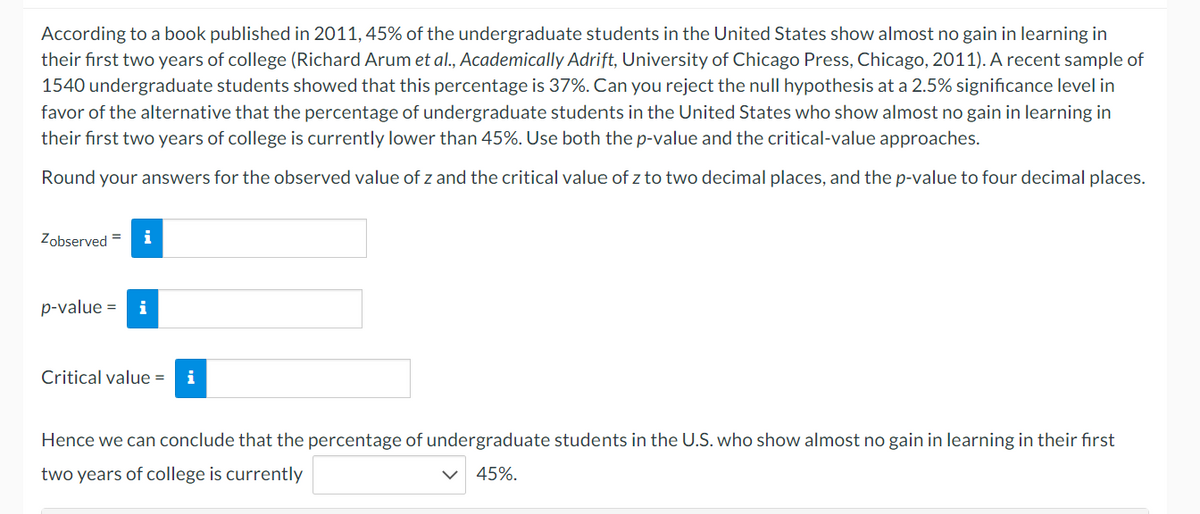According to a book published in 2011, 45% of the undergraduate students in the United States show almost no gain in learning in their first two years of college (Richard Arum et al., Academically Adrift, University of Chicago Press, Chicago, 2011). A recent sample of 1540 undergraduate students showed that this percentage is 37%. Can you reject the null hypothesis at a 2.5% significance level in favor of the alternative that the percentage of undergraduate students in the United States who show almost no gain in learning in their first two years of college is currently lower than 45%. Use both the p-value and the critical-value approaches. Round your answers for the observed value of z and the critical value of z to two decimal places, and the p-value to four decimal places. Zobserved = i p-value = i Critical value = Hence we can conclude that the percentage of undergraduate students in the U.S. who show almost no gain in learning in their fırst two years of college is currently v 45%.
According to a book published in 2011, 45% of the undergraduate students in the United States show almost no gain in learning in their first two years of college (Richard Arum et al., Academically Adrift, University of Chicago Press, Chicago, 2011). A recent sample of 1540 undergraduate students showed that this percentage is 37%. Can you reject the null hypothesis at a 2.5% significance level in favor of the alternative that the percentage of undergraduate students in the United States who show almost no gain in learning in their first two years of college is currently lower than 45%. Use both the p-value and the critical-value approaches. Round your answers for the observed value of z and the critical value of z to two decimal places, and the p-value to four decimal places. Zobserved = i p-value = i Critical value = Hence we can conclude that the percentage of undergraduate students in the U.S. who show almost no gain in learning in their fırst two years of college is currently v 45%.
College Algebra (MindTap Course List)
12th Edition
ISBN:9781305652231
Author:R. David Gustafson, Jeff Hughes
Publisher:R. David Gustafson, Jeff Hughes
Chapter8: Sequences, Series, And Probability
Section8.7: Probability
Problem 58E: What is meant by the sample space of an experiment?
Related questions
Question

Transcribed Image Text:According to a book published in 2011, 45% of the undergraduate students in the United States show almost no gain in learning in
their first two years of college (Richard Arum et al., Academically Adrift, University of Chicago Press, Chicago, 2011). A recent sample of
1540 undergraduate students showed that this percentage is 37%. Can you reject the null hypothesis at a 2.5% significance level in
favor of the alternative that the percentage of undergraduate students in the United States who show almost no gain in learning in
their first two years of college is currently lower than 45%. Use both the p-value and the critical-value approaches.
Round your answers for the observed value of z and the critical value of z to two decimal places, and the p-value to four decimal places.
Zobserved =
p-value =
Critical value = i
Hence we can conclude that the percentage of undergraduate students in the U.S. who show almost no gain in learning in their fırst
two years of college is currently
45%.
Expert Solution
This question has been solved!
Explore an expertly crafted, step-by-step solution for a thorough understanding of key concepts.
This is a popular solution!
Trending now
This is a popular solution!
Step by step
Solved in 3 steps with 3 images

Recommended textbooks for you

College Algebra (MindTap Course List)
Algebra
ISBN:
9781305652231
Author:
R. David Gustafson, Jeff Hughes
Publisher:
Cengage Learning

College Algebra (MindTap Course List)
Algebra
ISBN:
9781305652231
Author:
R. David Gustafson, Jeff Hughes
Publisher:
Cengage Learning